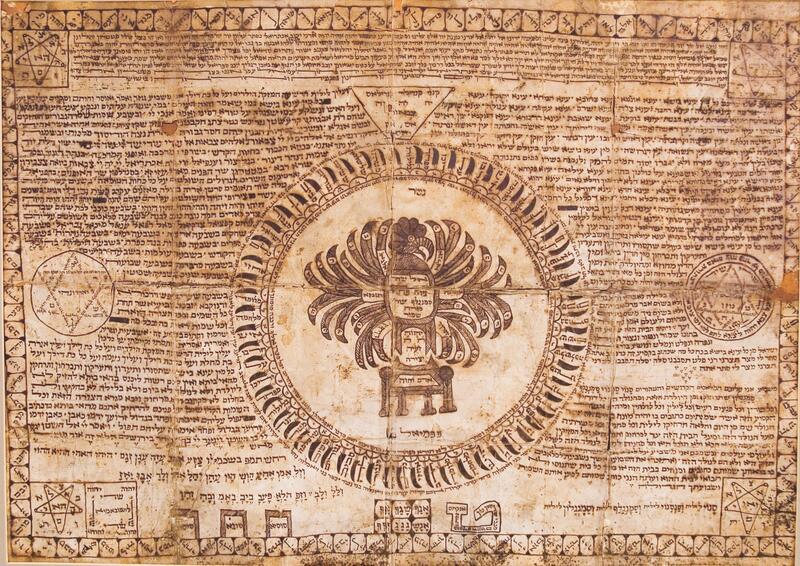From the Archive: Amulet for the Protection of Pregnant Women and Newborn Children
What we found
This elaborately detailed amulet from Kerala, Kochi was used to guard against both infertility and infant death. The single page, handwritten in ink on vellum, dates to 1800. It is loaded with images and words—and even images made up of words—in Hebrew, Aramaic, and Ladino (Judeo-Spanish). This writing in Ladino points to the population of Sephardic Jews in Kochi, descendants of those who were expelled from Spain in the fifteenth century.
One thing that makes this paper object unique within the Posen Library are the visible fold marks. The page is creased. These creases indicate that the person or people who used the amulet folded it up so that it was small enough to carry around or hold onto. The amulet was not meant just for display or reading; it was meant to do something for the person who possessed it.
The parchment intricately combines prayers, mystical formulas, quotations, names of angels, and various names of God. All of these serve to protect the user. At the center of the page, we see a drawing of a throne, likely meant to represent the chair of Elijah (kiseh shel eliyahu), used in circumcision rituals. Poised above the chair is a bird of prey, labeled as an eagle “nesher). Even as the ritual chair represents protection for the newborn, this image of the hostile bird reminds viewers of physical or spiritual dangers against which the child needs protecting.
The threatening bird of prey represents the demoness Lilith, a mythical character known as Adam’s first wife, who in Jewish tradition is notoriously bloodthirsty for babies. As a counterbalance to Lilith in this drawing, the names of Adam and Eve are written in Hebrew on the seat of the chair. These central images suggest an interplay between dangers and protections surrounding the newborn.
Why it matters
This amulet (in Hebrew, kameya) is one example of the widespread and longstanding Jewish tradition of safeguarding newborn children from the wrath of Lilith and from the evil eye. While customs vary around the globe, a common thread views Lilith as a powerful and envious force to which babies are especially vulnerable. Because of this widespread belief, the tradition of textual amulets for newborns can be found in many different Jewish communities. Like this amulet from Kerala, many others contain passages or names of angels, written on parchment.
Sephardic Jews created various forms of amulets; some were tied on strings and could be worn around the neck. Ashkenazi Jews also crafted textual amulets, sometimes tying them to babies’ cribs. The tradition of placing a red ribbon or string around a baby’s wrist exemplifies another tradition meant to ward off the evil eye (ayin harah).
Our especially complex example of a kameya from Kerala speaks to both the particular and the universal, the local and the global, within Jewish folk traditions and the supernatural.
Learn more
If you’re interested in learning more about the Jewish community of Kochi, and particularly about the religious and cultural practices of Jewish women there, check out this piece about the multilingual music of Jewish women from Kochi.
This post is part of JWA’s From the Archive column. It was written in partnership with The Posen Library of Jewish Culture and Civilization.









